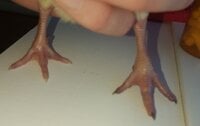How old were they when you got them? Were they shipped? What are you feeding?MY CHICKS ARE GONIG LAME AND (SLOWLY) DYING
Got new chicks (poults actually).
I had them 1.5 days
>>> and 2 died.
On the 2.5th Day
>>> 1 more died.
that night, noticed, lameness.
On the 3rd day
>>> 2 went lame, 1died.
1 of the 2 was suffering badly, we euthanized it.
They were ok for Saturday, and some of Sunday
and now Monday . . .
>>> 3 more are lame.
Have any photos of what they look like when they go lame before passing?
Possible it's simply failure to thrive/shipping stress?? This is my first suspect. How many birds did ya get total? Did your hatchery refund any that passed within (usually) the first 48-72 hours after you got them?






 Thanks for sharing your necropsy results.
Thanks for sharing your necropsy results.